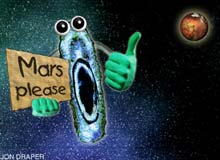Hitchhiking bacteria could compromise the detection of life on Mars

Is there life on Mars? It’s possible, but it may not be Martian, say scientists. New research, published in the open access journal BMC Microbiology, suggests that conditions on Mars are capable of supporting dormant bacteria, known as endospores. This raises concern about future attempts to detect Martian life forms because endospores originating on Earth could potentially hitch a ride to Mars and survive on its surface.
Soil on Mars is thought to be rich in oxidising chemicals that are known to destroy life. The high levels of ultraviolet radiation on the surface of the planet make it unlikely that any organism could survive. Ronald Crawford and colleagues from the University of Idaho have investigated whether bacterial endospores can exist in Mars’s hostile environment.
Endospores are a survival form of bacteria, formed when they find themselves in an unfavourable environment, and are perhaps the most resilient life form on Earth. They are resistant to extreme temperatures, most disinfectants, radiation, drying, and can survive for thousands of years in this dormant state. There is even evidence that they can survive in the vacuum of space. Given the possibility of endospores hitching a lift on spacecraft bound for Mars, Ronald Crawford and his colleagues investigated whether endospores could survive in a simulated Martian environment.
Martian soil was created by mixing dry sand containing endospores with ferrate. The soil was then left at –20 oC and exposed to high levels of UV light for six weeks. These conditions were designed to simulate the dry, cold, oxidizing environment found on Mars. Subsequent analysis of the soil showed that endospores were still alive below a depth of 5mm, suggesting that life is possible in these hostile conditions.
The authors speculate, “that if entities resembling bacterial endospores were produced at some point by life forms on Mars, they might still be present and viable, given appropriate germination conditions.”
Although the researchers have not found direct evidence for life on Mars their research does throw up a potential problem with future space missions. The survival of endospores in such adverse conditions raises the possibility that bacterial endospores could travel to Mars on the surface of spacecraft and survive on Martian soil. This could seriously compromise future efforts to establish whether there is, or has been life on Mars, as it would be difficult for researchers to know whether any endospores found originated from Earth or Mars.
Whilst this work establishes that bacterial endospores can survive exposure to the conditions probably found on Mars, it should be noted that it was not possible to test whether their simulated Martian environment would kill endospores over a geological timescale.
Media Contact
All latest news from the category: Life Sciences and Chemistry
Articles and reports from the Life Sciences and chemistry area deal with applied and basic research into modern biology, chemistry and human medicine.
Valuable information can be found on a range of life sciences fields including bacteriology, biochemistry, bionics, bioinformatics, biophysics, biotechnology, genetics, geobotany, human biology, marine biology, microbiology, molecular biology, cellular biology, zoology, bioinorganic chemistry, microchemistry and environmental chemistry.
Newest articles

Sea slugs inspire highly stretchable biomedical sensor
USC Viterbi School of Engineering researcher Hangbo Zhao presents findings on highly stretchable and customizable microneedles for application in fields including neuroscience, tissue engineering, and wearable bioelectronics. The revolution in…

Twisting and binding matter waves with photons in a cavity
Precisely measuring the energy states of individual atoms has been a historical challenge for physicists due to atomic recoil. When an atom interacts with a photon, the atom “recoils” in…

Nanotubes, nanoparticles, and antibodies detect tiny amounts of fentanyl
New sensor is six orders of magnitude more sensitive than the next best thing. A research team at Pitt led by Alexander Star, a chemistry professor in the Kenneth P. Dietrich…





















